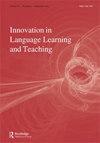第二语言技能特异性焦虑和沟通理解:校外英语在土耳其语境中的作用
IF 4.6
3区 教育学
Q1 EDUCATION & EDUCATIONAL RESEARCH
Innovation in Language Learning and Teaching
Pub Date : 2023-05-30
DOI:10.1080/17501229.2023.2217170
引用次数: 0
摘要
目的:本研究有三个目的:(1)探讨外部英语(EE)投入、第二语言/额外语言(L2)焦虑和沟通理解之间是否存在统计学上显著的关系;(2)调查情感表达投入是否预测这两个构式;(3)揭示不同情感表达活动可能的预测能力。研究方法:本研究采用调查方法。对252名在挪威北部一所州立大学学习英语的第二语言学习者进行了封闭式问卷调查。除了测量第二语言焦虑和CA的量表外,问卷还包括与情感表达活动相关的六个项目(即玩电子游戏、看电视、听力相关、阅读相关、写作相关和口语相关)。采用Spearman相关分析和多元回归分析对数据进行分析。研究发现:情感表达投入与第二语言焦虑在不同程度上呈显著负相关,玩电子游戏与听力焦虑呈中等相关;与说话相关的情感表达与说话焦虑之间的关系;与口语相关的情感表达和CA之间存在显著的负向关系。情感表达参与显著地预测了三个变量:它解释了17%的听力焦虑、17%的口语焦虑和15%的CA。虽然玩电子游戏和口语相关的情感表达是听力和口语焦虑的显著预测因子,但口语相关的情感表达是CA的唯一显著预测因子。这些发现表明,频繁的情感表达参与减少了消极情感状态,情感表达是减少二语听说焦虑和CA的预测因素之一。这表明情感表达可以通过增强积极情感状态在二语学习中发挥重要作用。本文章由计算机程序翻译,如有差异,请以英文原文为准。
L2 skill-specific anxiety and communication apprehension: the role of extramural English in the Turkish context
Purpose: The present study has three objectives: (1) to explore whether there are statistically significant relationships between Extramural English (EE) engagement, second/additional language (L2) anxiety and communication apprehension, (2) to investigate whether EE engagement predicts these two constructs, and (3) to reveal possible predictive abilities of different EE activities.Methodology: This research implemented a survey methodology. A closed-ended questionnaire was administered to 252 L2 learners of English who studied at a state university in Northern Türkiye. In addition to the scales that measured L2 anxiety and CA, the questionnaire comprised six items related to EE activities (i.e. playing video games, watching TV, listening-related, reading-related, writing-related, and speaking-related EE). The data were analysed using Spearman’s correlation and multiple regression analyses.Findings: Significant, negative correlations were found between EE engagement and L2 anxiety at different levels, with moderate relationships between playing video games and listening anxiety; between speaking-related EE and speaking anxiety; between speaking-related EE and CA. EE engagement significantly predicted three variables in negative ways: it explained 17% of listening anxiety, 17% of speaking anxiety, and 15% of CA. While playing video games and speaking-related EE were significant predictors of listening and speaking anxiety, speaking-related EE was the only significant predictor of CA.Originality/value: These findings indicate that frequent EE engagement decreases negative affective states and EE is one of the predictors of decreased L2 listening- and speaking- anxiety and CA. This suggests that EE could play a significant role in L2 learning by enhancing positive affective states.
求助全文
通过发布文献求助,成功后即可免费获取论文全文。
去求助
来源期刊

Innovation in Language Learning and Teaching
LINGUISTICS-
CiteScore
6.90
自引率
6.70%
发文量
54
期刊介绍:
Innovation in Language Learning and Teaching is an international refereed journal devoted to innovative approaches to methodologies and pedagogies in language learning and teaching. It publishes research articles, review articles and book/materials reviews. It draws on a range of disciplines that share a focus on exploring new approaches to language learning and teaching from a learner-centred perspective. It will appeal to anyone interested in the development of, research into or practical application of new methodologies in language teaching and learning.
 求助内容:
求助内容: 应助结果提醒方式:
应助结果提醒方式:


